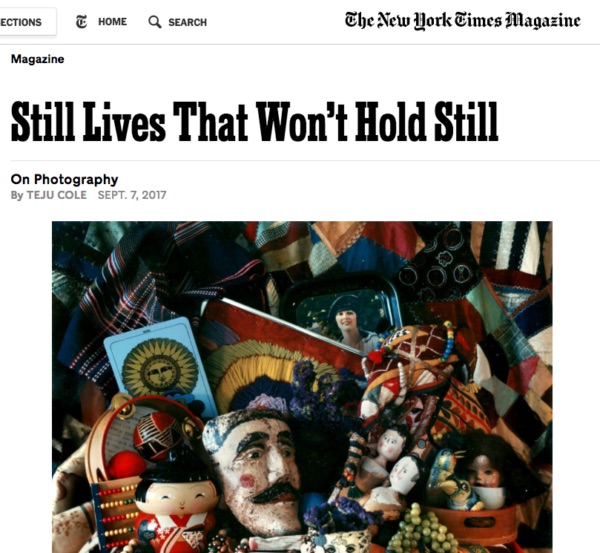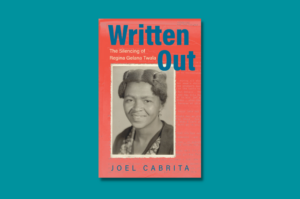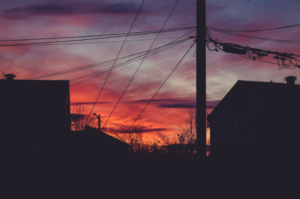When a writer who is also a photographer writes a piece about photography, one can only expect wonderful things.
In his new essay titled “Still Lives That Won’t Hold Still”, Open City author Teju Cole pays homage to the late renowned photographer Marie Cosindas, who passed away in May at the age of 93.
In the first part of the essay, Cole compares the experience of viewing Cosindas’ photos to “watching a single sentence unfurl over several pages, driven along by an invisible inner consistency…” He then allows the reader to discover that the essay itself is, in fact, one long sentence.
By taking this ingenious approach to honoring Cosindas, Cole recreates for the reader the distinct sensation of interacting with her body of work. Throughout the essay, he touches on noteworthy aspects of her life, extols her signature technique, and puts her work in conversation with artists from a range of disciplines.
The piece is inventive and mesmerizing all by itself. But, as Cole observes in a note he posted on Facebook, the essay is also the longest sentence ever published by the New York Times.
We congratulate Teju Cole on writing such beautifully experimental work!
Here is how the sentence begins:
Marie Cosindas, who was born in Boston in September 1923 and who died in the same city in May of this year at age 93, made photographs of such potency that they seem magical, dependent on something beyond mere sleight of hand for their mesmerizing effects and unified mood, so that the experience of looking at a selection of them is like watching a single sentence unfurl over several pages, driven along by an invisible inner consistency, not unlike the atmosphere of imaginative abundance that Gabriel García Márquez evoked in his novel “One Hundred Years of Solitude,” an atmosphere he used as the backdrop for the dense saga of the Buendía family in the mythical town of Macondo, and especially in his account of the magician Melquíades, a “heavy Gypsy with an untamed beard and sparrow hands,” a bearer of dazzling and arcane knowledge, including visions of the present and the future, as well as the secrets of optics, telescopes and magnetism, so that many different kinds of insight seem to find a natural unity inside him, and whose work re-emerges in the final pages of the novel in Sanskrit parchments, with “the even lines in the private cipher of the Emperor Augustus and the odd ones in a Lacedaemonian military code,” the inscrutabilities layered on one another to arrive at a startling lucidity of the kind that might be experienced by someone whose tangled dreams, regardless of their wildness or relentlessness, give way to a pure vision of wakefulness, though not the uninflected wakefulness of one who rises in early morning to a hot and innocent white light but rather the shadowed knowingness of one who has slept all day and awakes to the infinitesimally graded colors of a deepening evening, a moodiness recognizable to any viewer of Cosindas’s photographs, which make the most of small, dark spaces, a talent that perhaps originated in her being the eighth of 10 children raised by Greek immigrant parents in a small South Boston apartment, just as her experience as a child attending her parents’ Greek Orthodox church, with its gilded Byzantine icons and busy walls, was possibly the origin of her luminous sense of color and the suggestion of incense even when there is no smoke to be seen, a dimension of her work which certainly did not arrive instantaneously, though it did finally arrive, after she had worked as a painter and also as a photographer in black and white, including time spent in the workshop of Ansel Adams, whose grayscale lessons she abandoned in order to take up color with an alchemical force that is reminiscent of the great Amsterdam painter Rachel Ruysch, a widely celebrated artist in the very first rank of still-life painters of the Dutch golden age, who was active from the final quarter of the 17th century until shortly before her death in 1750 at age 86, and who, moreover, was one of very few women to be feted in that profession, and who outgrew both her botanist father and painter husband, outshining them in reputation as she consolidated both botanical and artistic knowledge, while raising 10 children, to produce ferociously accurate bouquets of flowers, some of which were literal works of fiction that showed in a single vase blooms that would have been seen in life only in different seasons but which through the magical art of painting could permanently be brought together, each precisely painted and often accompanied by equally fine depictions of marble plinths, tabletops, vases and insects, the entire arrangement set against a dark background, as was the vogue during the maturity of Dutch floral painting, a branch of art that was the elevation of the most modest and domestic material into an intensity that approached the sublime, a gift given to only a few: to leverage the ordinary into the glorious, to turn the soft petals of flowers into a flamelike radiance,
Read the full article HERE.
Image Source: Observe Nigeria









A.O February 14, 2020 05:15
Teju has applied a style of writing done by many such as James Joyce, Samuel Beckett, Virginia Woolf, called the stream of consciousness. It is inventive, but Teju did not invent it (he reads vastly and knows this). Teju is a wonderful writer that I admire. He is brilliant. That it states that its the first time its been done in The New York Times, speaks specifically where this innovation has been applied. And Teju has a wonderful sensitivity to creative writing.